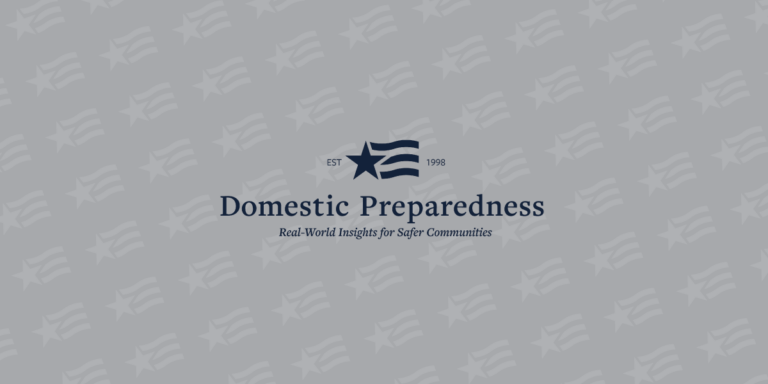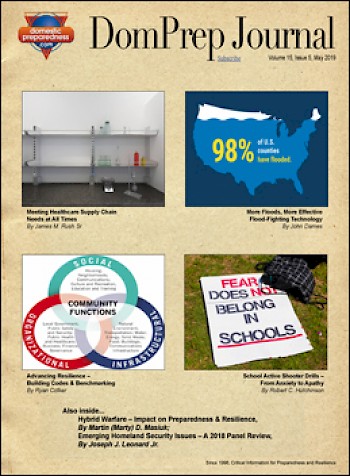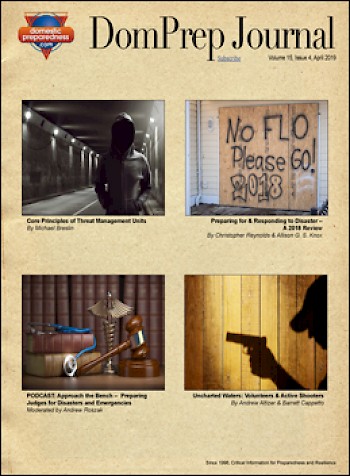
Author Archive

The Tribal Mitigation Planning Handbook provides practical approaches and advice for tribal governments as they develop their hazard mitigation plans. The handbook is organized around the seven recommended steps for developing a tribal mitigation plan. It also provides considerations for how to implement the mitigation plan, advance mitigation activities, and

National Health Security Preparedness Index – May 2019
Domestic Preparedness
June 12, 2019
The National Health Security Preparedness Index tracks the nation’s progress in preparing for, responding to, and recovering from the health consequences of disasters, disease outbreaks, and other large-scale emergencies. This report details the key findings from this year’s Index report. https://nhspi.org/wp-content/uploads/2019/05/NHSPI_2019_Key_Findings.pdf

Preparedness and Safety Messaging for Hurricanes, Flooding, and Similar Disasters
Domestic Preparedness
June 4, 2019
The Centers for Disease Control and Prevention developed a reference document that contains key messages on hurricane- and flood-related health threats. The document can help local responders quickly create and adapt health communication products for affected communities. The document contains messages on various topics including food safety, carbon monoxide poisoning, waterborne

May 2019
Domestic Preparedness
May 29, 2019
Featured in this issue: Strengthening Threat-Mitigation Efforts in Changing Times, By Catherine L. Feinman; Hybrid Warfare – Impact on Preparedness & Resilience, By Martin (Marty) D. Masiuk; Meeting Healthcare Supply Chain Needs at All Times, By James M. Rush Sr.; Emerging Homeland Security Issues – A 2018 Panel Review, By

United States Government Global Health Security Strategy 2019
Domestic Preparedness
May 21, 2019
The Global Health Security Strategy outlines the U.S. government’s approach to strengthen global health security, including accelerating the capabilities of targeted countries to prevent, detect, and respond to infectious disease outbreaks. https://www.whitehouse.gov/wp-content/uploads/2019/05/GHSS.pdf

Public Safety Communications – Ten Keys to Improving Emergency Alerts, Warnings & Notifications
Domestic Preparedness
May 20, 2019
Emergency alert, warning, and notification (AWN) systems help protect lives and property by identifying information about an impending threat, communicating that information to those who need it, and facilitating the timely taking of protective actions. This report contains recommendations to help organizations enhance critical information sharing. https://www.dhs.gov/sites/default/files/publications/safecom-ncswic_ten_keys_to_improving_awns_4.26.19_-_final_section_508_compliant.pdf

Prioritizing Zoonotic Diseases for Multisectoral, One Health Collaboration in the United States
Domestic Preparedness
May 11, 2019
The Centers for Disease Control and Prevention, U.S. Department of the Interior, and U.S. Department of Agriculture have released the first federal collaborative report listing the top zoonotic diseases of national concern for the United States, including recommendations for next steps. Zoonotic diseases are illnesses that can spread between animals

Vaccine Platforms: State of the Field and Looming Challenges
Domestic Preparedness
May 6, 2019
The Johns Hopkins Center for Health Security conducted a project aimed to develop a state-of-the-art conceptual understanding of various vaccine platform technologies, with special attention on how they may speed development of vaccines for global catastrophic biologic risks and emerging infectious disease outbreaks. This report describes major scientific and policy

Weapons of Mass Distraction: Foreign State-Sponsored Disinformation in the Digital Age
Domestic Preparedness
May 1, 2019
A growing number of states, in the pursuit of geopolitical ends, are leveraging digital tools and social media networks to spread narratives, distortions, and falsehoods to shape public perceptions and undermine trust in the truth. An effective response to this challenge requires understanding the converging factors of technology, media, and

April 2019
Domestic Preparedness
April 24, 2019
Featured in this issue: Hybrid Warfare – Merging Old & New Age Threats, By Catherine L. Feinman; Core Principles of Threat Management Units, By Michael Breslin; Preparing for & Responding to Disaster – A 2018 Review, By Christopher Reynolds & Allison G. S. Knox; Podcast: Approach the Bench – Preparing
Follow Us
Get Instant Access
Subscribe today to Domestic Preparedness and get real-world insights for safer communities.
ARchives
Article Out Loud – Integrating Law Enforcement & Emergency Management
November 8, 2022
When a tornado touches down, a school is under fire, or another disaster strikes, patrol officers often are the first response personnel at the scene. In addition to their traditional crime-fighting roles, patrol officers must be able to manage an incident until more support arrives, which requires additional training for
Article Out Loud – A Revised Definition of Homeland Security
November 8, 2022
A top-down approach provides guidance and support from federal agencies to local jurisdictions. A bottom-up approach ensures that local needs are being heard at the top. However, when local agencies are tasked with national security efforts, more guidance and support may be needed from above.
Article Out Loud – Training the Next Generation of Cyber Guardians
November 2, 2022
Despite small local governments being overrun with malware, ransomware, and myriad other threats, it is difficult to find experienced cybersecurity professionals. Meanwhile, students search for nonexistent entry-level jobs. One Washington State-based nonprofit is seeking to close this cybersecurity gap.
Article Out Loud – Nuclear Threats Against the Homeland: Impact and Preparation
November 2, 2022
How the war in Ukraine will end is unclear. However, research shows that there is the potential for devastating effects on a global scale. As such, it is important for emergency planners to reassess their all-hazards plans to ensure their communities identify the threats and ensure their planning processes include
Article Out Loud – Community Resilience & Functional Needs
November 1, 2022
Many cities across the United States are not adequately prepared to accommodate people with disabilities during and in the wake of major disasters. However, some of the current gaps in whole-community preparedness are beginning to close. If more-inclusive planning efforts continue to expand, communities will be able to better meet
Article Out Loud – Hospital Response to a 10-Kiloton Nuclear Detonation
November 1, 2022
If a nuclear device were to be detonated within any of the nation’s major metropolitan areas, the healthcare system both inside and outside the blast-damage zones would be seriously affected. Predicting the “what ifs” and planning for such scenarios can help hospitals and responder agencies cope with and manage the
Article Out Loud – A Communicator’s Overview of a Large-Scale Exercise
October 26, 2022
A June 2022 exercise challenged amateur radio operators with establishing a Communications Unit with no power or pre-positioned equipment. The exercise was successful, but the key takeaways are already helping to improve collaboration and communications throughout the region.
Article Out Loud – Rationale for Structuring Pandemic Response on a War Footing
October 26, 2022
Given 20 years of pandemic planning, is it not surprising when people ask, “Why were we not ready?” This question should be explored whether the time has come to put the country on a warlike footing for pandemic response with a coherent, institutionalized, and tested pandemic policy.
Article Out Loud – Monkeypox: A Public Health Update
October 19, 2022
The current monkeypox outbreak is different from historical outbreaks that remained endemic and rarely became international events. Now the situation is changing daily. This article explains what precautions are needed to prevent the spread and how new approaches should be implemented to tackle it.
Article Out Loud – Earthquakes & Pandemic – Keeping People Fed Amid Crises
October 19, 2022
Even though food is necessary for survival, it is not common to see agricultural workers at a disaster training exercise. However, one organization demonstrates why training these volunteers with emergency preparedness and response skills is essential for future large-scale disasters.
Follow Us
Get Instant Access
Subscribe today to Domestic Preparedness and get real-world insights for safer communities.


